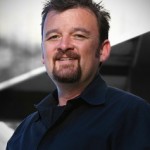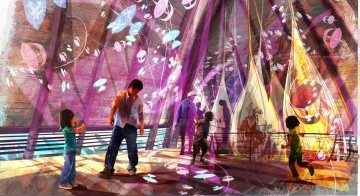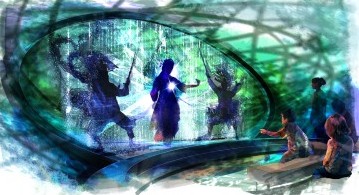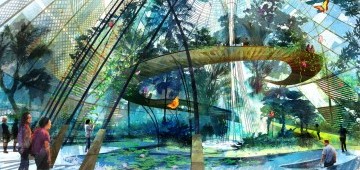Two eco-tourism island leisure projects in Malaysia are being designed and developed by Robert Wyatt’s company Pekan Artisan Sdn Bhd (Kuala Lumpur) which signed an agreement on June 2 with the Langkawi Development Authority (LADA). Pekan Artisan is sister company to Artisan Design (Venice/Las Vegas/New York) also headed by Wyatt.
The development will be on two sites of Langkawi, an archipelago of 99 tropical islands 30km off the west coast of Malaysia.

The 33-acre Site 1 will be the Paradise Island Hotel & Gardens, with a 250-room hotel in a rainforest landscape with retail, restaurants, hiking paths and 4 multimedia attractions celebrating local culture and wildlife. The Gardens have been described in the press as an “eco-theme park.”
The 22-acre Site 2 is destined to become Sultan’s Summer Palace, an upscale resort with a 100-room hotel and 17 villas. Amenities will include a helipad, conference facility, high-end restaurants, media experience and spa set in an environment combining design and nature.
Judith Rubin interviewed Robert Wyatt for InPark Magazine:
The last project of yours we covered was the Capitol Theatre renovation in Edmonton, Canada – an impressive attraction, but nothing like the scale of this. How did Artisan Design give birth to Pekan Artisan the international developer?
It’s been my goal and mission for several years to do this. I’ve helped many clients develop these kinds of projects and wanted to get to the point where I could control funding, site and content. The turning point came about a year and a half ago while Artisan Design was in Malaysia working on two shows for Melaka Alive! LADA contacted us to talk about potentially developing projects on the Langkawi islands. Many pitches and meetings later, we landed an 80-year, renewable lease agreement to develop two unique sites.

This is a USD$220 million project for the first phase. Three of us – Saifful Azhar Sabaruddin, Tiew Lai Hin and I, now the executive team of Pekan Artisan – worked to deliver the master plan for the development. Then we went out to larger investment groups; we have been in negotiation with 4-5 different groups for private equity, and are also working with local banks. Ten percent of the budget, for infrastructure development, comes from federal monies through the Malaysian government. Pekan Artisan, as the developer, has full control over all designs and content, but we are working hand-in-hand with the state and federal governments, the Ministry of Finance and with LADA. The Malaysian government has been very supportive.
I’d worked on large-scale endeavors before. With BRC Imagination Arts, I was a creative and executive on the Abraham Lincoln Museum & Library, a $150 million project. As an independent, I was one of the lead consultants for Dubailand, which comprised around $7 billion worth of development. My experience with those and others gave me the confidence to go out on my own and start developing projects that I believed in.
What are the four attractions, and what is the project timeline?
The gardens – Site 1 – will open at the end of 2015 and will include the 4 attractions. This be followed by hotels in 2016. That’s the first phase.
The primary attraction is a 4D immersive dome flyover experience. The dome will carry the National Geographic Cinema Ventures brand. DJW is in charge of the AV integration. The other 3 attractions are the cultural village, the interactive theater and the bio-dome, showcasing local flora and fauna. In the cultural village will be interactive environments containing “myth pods” that celebrate stories of myths and legends of Langkawi. The bio-dome will be contiguous with the hotel; guests will enter through it.
The second phase of Site 1 will begin with a large projection show on the mountain, using cultural and historical imagery. Other aspects of the second phase are tree-top walks, rope bridges, a wilderness adventure park, a VIP tree-top resort and more hotels. The resort – Site 2 – is scheduled to be built at the same time, with both scheduled to be completed in 2017.
Who will handle operations once the facilities are open?
We are looking at different options for operating the attractions, and will be going out to the community for bids. On the hotels we’re in talks with 5-6 different brands.

What makes this project special for you?
It’s built into our name. The word Pekan means Village. Like the word Artisan, it signifies cultural awareness. That word denotes working with people locally: their stories, their legend, their nature.
The intention is to design something in nature and surrounded by nature, not to take over nature. We’re also talking about it being off the grid, using energy from solar, geothermal and other eco-friendly sources. It will be built sustainably and we aspire to a LEED Gold rating or higher. I feel all the more connected to the project being of Southeast Asian descent myself – half Indonesian and Dutch.
Eco-tourism projects have become a specialty for us. We are constantly trying to push our designers and vendors to design and implement processes and materials that embrace the local flora and fauna.
Please share some highlights of your past work in Asia.
For Melaka Alive! in Melaka, Malaysia, we developed a show about the history of Malaysia. For ZN Magic World Theme Park in Shenyang, China, I worked on several attraction concepts. For Images of Singapore on Sentosa Island (with BRC Imagination Arts) I was the Project Director and worked on the redevelopment of the attraction and plaza area.

As a seasoned designer and producer who has seen a lot of projects come together for good and bad, what are some of the important lessons you’ve learned and how are they informing this project?
Lesson number one: In terms of design money, apply budget at the front end, working out all design and potential issues before you go into the field and are change-ordered to death by construction groups because of things you haven’t figured out.
That’s an interesting observation to make at a time when so many are extolling design/build as a way of saving time and money.
I’ve seen design/build lead to 20% in cost overruns. Good design/build only happens when everyone on the team has done those kinds of projects before. Which brings me to lesson number two: Use groups that have the skills you need, and use the right tools. There are crucial differences between building attractions and conventional construction, and they show up in areas such as architecture, distribution of controls, lighting… even the choice of design software.
What is the target market for these attractions, and what visitation is projected?
Preliminary feasibility studies show that the audience comes from within a 5-hour travel radius, and that they are mostly Thai, Chinese, Singaporean and Malaysian. We’ve put extra budget allotment toward marketing to the international community and are working with several marketing consultants and groups. In 2015-2016 we plan on seeing attendance levels of 800,000 guests; once we open the second phase in year 2017-2018 we plan on seeing attendance rise to 1.2 million guests.
Who are some key members of your team?
Stratford Hospitality (Jan Redrupp): Hotels; Keith Ray: Architect & Retail Developer; FSY Architects (Vijay Seghal): Theatrical Architect and Artisan Design, our US entity, is working on the Gardens and theatre environments for this project.
It seems likely that this project will be compared to Aulani.
It will be an honor to be compared to Aulani. We are working with local experts and historical advisers to ensure authenticity and accuracy.

What else does the future hold for Artisan?
In New York and London, Artisan Design is working on a theater attraction that we’ll most likely be developers for – so stay tuned! Also, we are working on an animated series in collaboration with Ralph Guggenheim.
We are very optimistic about the future of the resort and attractions industry in Southeast Asia. Thailand just got the vote for “most popular hospitality investment market in Asia” from the industry executives attending the Asia Pacific Hotel Investment Conference this spring. The next most favored were Cambodia, Myanmar, Indonesia, Vietnam and the Philippines. We’re looking forward to doing more developments like Langkawi.
As this East-West collaboration takes shape in Langkawi, industry creatives and suppliers will want to know how they can apply to be part of your team.
For the attraction components, we’re looking for project managers and art directors, and interested parties should send their information to [email protected].
We haven’t hired any of the management team for the attraction side. On the hotel side, Keith Ray is the developer, and will be hiring a project manager. We are looking at construction groups to build the project, and those most likely will be Malay or Southeast Asian firms.
Most of the front-end design work will be by groups I’ve used in the US, and we will be working with local architecture firms for construction documentation and implementation. We have separate hotel architects and separate attraction architects. There will be a core team managing the entire project, and that team is still in the process of being assembled.
[author] [author_image timthumb=’on’]http://4.bp.blogspot.com/-fngvxyYk8nU/US_Ae2Q3YyI/AAAAAAAAGqo/954GDEqn0-g/s200/DSC01396.JPG[/author_image] [author_info]Judith Rubin is co-editor of InPark Magazine.[/author_info] [/author]





